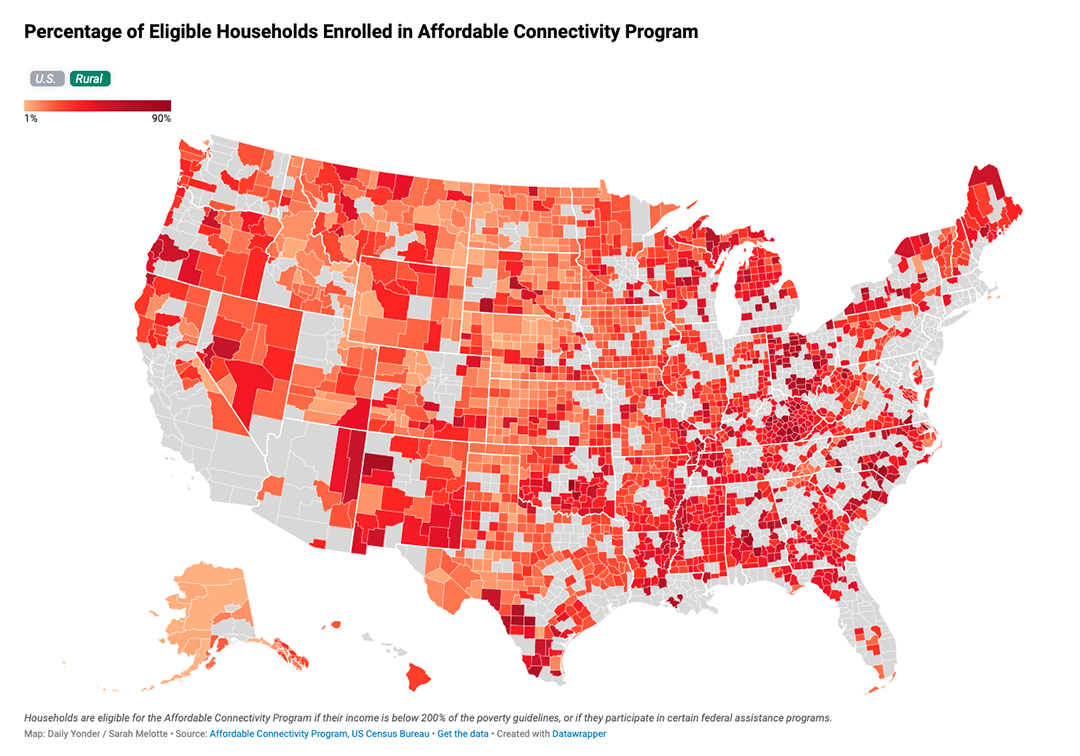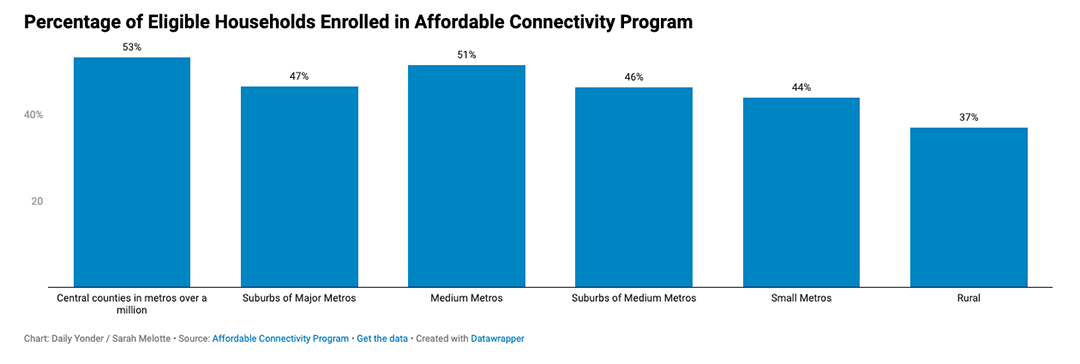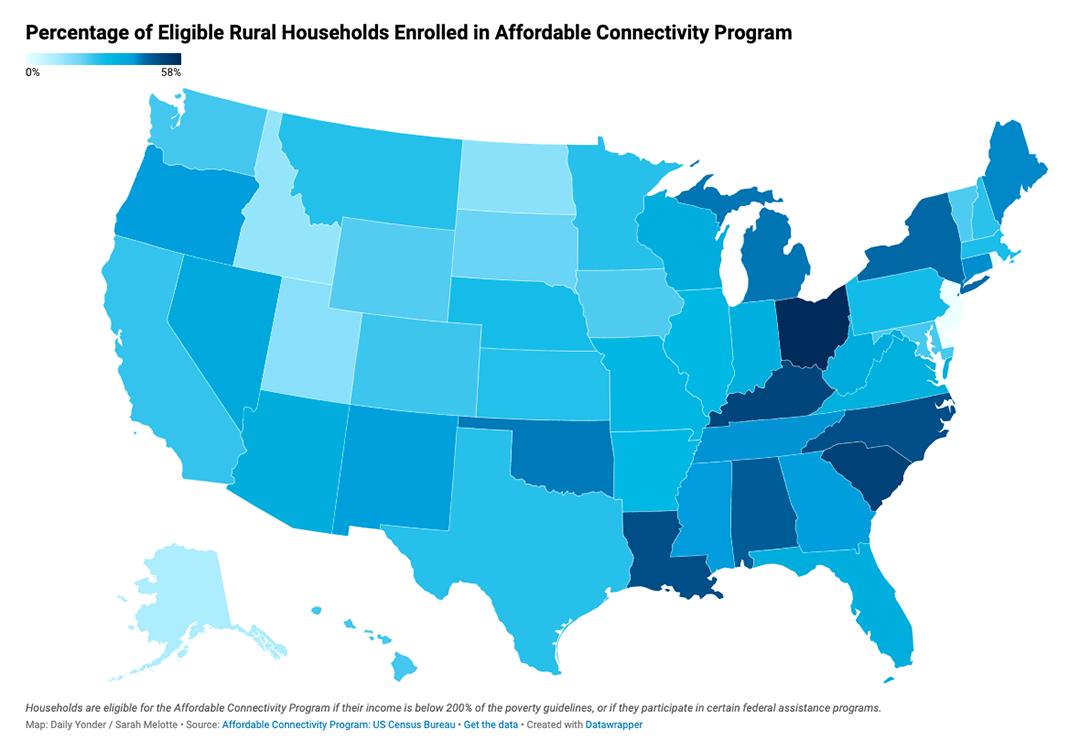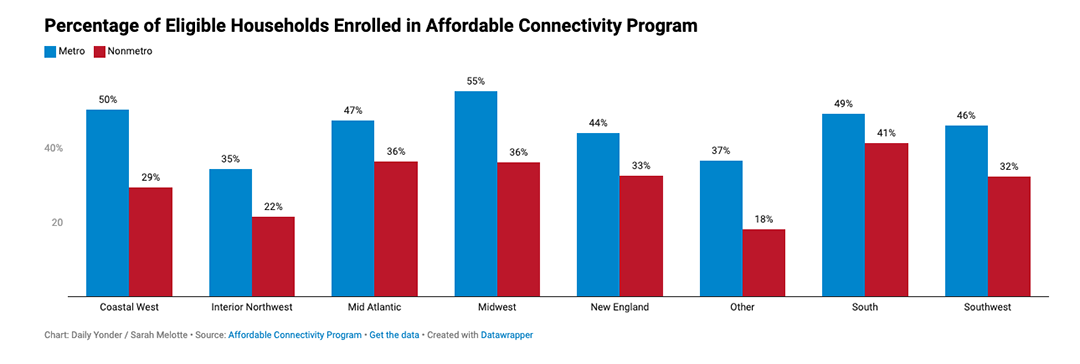Rural Americans were less likely to enroll in a federal broadband assistance program. Now it's too late to sign up

Amy Johansson // Shutterstock
Rural Americans were less likely to enroll in a federal broadband assistance program. Now it’s too late to sign up
Earth digger used to dig down cables for broadband connection in rural area
Rural households were not as likely as their urban counterparts to enroll in the Affordable Connectivity Program (ACP), a federal fund that is running out of money to help low income families connect to the internet.
About a third (37%) of rural households that are eligible for the monthly discount on broadband subscriptions had enrolled in the program as of December 2023. The Daily Yonder conducted an analysis that showed that 3.2 million rural households had signed up for the benefit, while just over half of eligible metropolitan households have enrolled in the program.
![]()

Daily Yonder // Sarah Melotte
Who took advantage of the affordable connectivity program?
U.S map showing percentage of eligible households enrolled in rural areas
The program stopped taking new applications for support February 8 and will run out of funding in late April, according to a letter to Congress sent by the Federal Communications Commission (FCC). Even the residents who met the enrollment deadline aren’t totally in the clear. Current program participants, including millions of rural households, are at risk of losing benefits if Congress doesn’t approve additional funding to keep the program running.
Before ACP stopped accepting new enrollments last week, households were eligible to sign up to receive a broadband discount of up $30 per month if their income was at or below 200% of the Federal Poverty Guidelines, or if they received aid from certain federal assistance programs like SNAP or Medicaid.
An estimated 5.4 million rural households met these criteria but did not sign up for ACP, something the Benton Institute for Broadband and Society said was probably due to lack of awareness about the program.
People who lived in cities with over 1 million residents were more likely to take advantage of ACP compared to all other geographies. Fifty-three percent of eligible households were served by ACP in those major metropolitan areas last December, compared to about 47% of households in the suburbs of those cities.

Daily Yonder // Sarah Melotte
Participation rates in small cities lag behind mid- and large-population cities
bar chart: percentage of eligible households enrolled in affordable connectivity program
Participation rates in cities with populations between 250,000 and one million were comparable to the major cities. About half of eligible households were enrolled in those medium-sized metros, while small cities with fewer than 250,000 residents only had a participation rate of 44%.
“Factors like very low incomes, lack of labor force participation, and some sociodemographic factors are all strongly positively related with ACP adoption,” said Brian Whitacre, a rural economist at Oklahoma State University.
Enrollment is likely to be higher in places where a greater share of the population is African American or Hispanic, or where residents have lower education attainment, according to Whitacre.
“Other social and community indicators are important, like access to a library,” Whitacre said.
Rural residents generally have less access to libraries and other kinds of infrastructure that makes it easier for people to sign up for federal programs, as we’ve previously reported.
“Distance is a penalty,” wrote Benton Institute Senior Fellow John Horrigan in a report about rural participation in ACP. “[Rural] people are farther away from public libraries and other anchor institutions that may facilitate ACP enrollment. Word-of-mouth about the program from trusted neighbors may have less impact with fewer people nearby.”
Horrigan also attributes lack of broadband availability to low enrollment rates in rural areas. Households that can’t get wired broadband service at any price aren’t helped by a $30 subscription subsidy. Whitacre said some states have also done a better job than others at promoting ACP and encouraging eligible people to sign up.

Daily Yonder // Sarah Melotte
Rural participation was dire in Alaska, Idaho, Wyoming
map: percentage of eligible rural households enrolled in affordable connectivity program
Alaska had the lowest rural participation in the nation. Only 4,666 rural Alaskan households (about 10% of eligible households) were enrolled, leaving behind 38,000 households in need of broadband assistance in the state. Participation rates in some rural Alaskan areas, like Yakutat City and North Slope Borough, barely exceed a percentage point of all eligible households.
But Alaska’s low enrollment is likely due to the lack of service availability in remote regions, according to data from the FCC’s Broadband Map. People generally have access to broadband in cities like Fairbanks and Anchorage, but it’s much harder to come by in the state’s most rural areas.
States like Idaho and Montana also have pockets of missing coverage in the most rural areas. In Prairie County, Montana, for example, only 31% of the county has access to an internet speed of 25MBps, which most consider insufficient to power multiple devices. Only 5% of eligible households in Prairie County are enrolled in ACP.
In Idaho, meanwhile, only 15% of rural households that could have signed for ACP actually did so, which means that 85,000 rural Idahoan households that could benefit from the broadband discount now won’t be able to enroll, even if they do live in an area with access.
On the Montana border in Clark County, Idaho, only 236 rural households were enrolled in ACP, 1% of the total households that meet the eligibility criteria.
Twenty-three percent of eligible households in rural Wyoming were enrolled in ACP, exceeding Idaho’s rate by 8 percentage points but still falling behind the national rural participation rate of 37%. Eleven thousand rural Wyoming households were receiving aid through ACP in December, leaving 38,000 households potentially in need of assistance.

Daily Yonder // Sarah Melotte
Rural Southerners took advantage of ACP benefits
bar chart comparing metro and non metro Percentage of Eligible Households Enrolled in Affordable Connectivity Program
The South had the best rural participation rates in the nation in December. Forty-one percent of eligible rural households in Southern states were enrolled in ACP. About half of eligible urban southerners were signed up.
North Carolina has the most rural participants in ACP by raw numbers. About 217,000 rural North Carolinian households were enrolled in December, comprising about half of the total rural households eligible.
In rural Richmond County, North Carolina, 89% of eligible households received funding through ACP. Nearby Scotland and Robeson counties also had participation rates exceeding 75% of eligible households.
South Carolina had the best rural enrollment based on a percentage basis. The rural population in South Carolina is smaller than North Carolina, so there are fewer enrollees. But 52% of all eligible households in rural South Carolina were enrolled in December, compared to 49% in North Carolina.
In rural Dillon County, South Carolina, ACP served 7,500 households, about 79% of eligible households.
The state with the second highest rural participation rate was Kentucky, where 51% of eligible households were enrolled in ACP. Over 200,000 rural Kentuckian households took advantage of the broadband discount in December. Rates were particularly high in eastern Kentucky communities like Whitley County, where 74% of eligible households received broadband.
On the national level, enrollment was best in metropolitan areas of the Midwest, where 55% of eligible households were receiving some kind of discount through ACP. But only 36% of eligible households in rural Midwestern counties were enrolled.
This article defines rural as nonmetropolitan counties based on the 2013 Office of Management and Budget Metropolitan Statistical Areas.
This story was produced by The Daily Yonder and reviewed and distributed by Stacker Media.